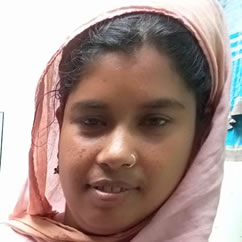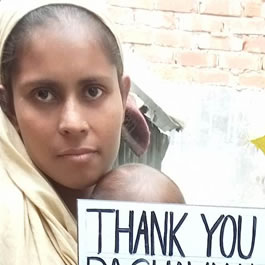Supportive Blankets Providing Warm & Comfort, In Bangladesh
- David Burgess
- Dec 10, 2024
- 7 min read
Key Takeaways
Supportive blankets provide crucial warmth and comfort, especially in emergency situations.
Heavy-duty thermal blankets are essential for protection against harsh weather conditions.
Sponge mattresses with covers offer a comfortable sleeping surface, preventing contact with cold, hard grounds.
Effective distribution of these items is critical in regions affected by extreme weather or crisis.
Collaborating with aid organizations enhances the reach and impact of providing these essentials.

A Lotus Ministry Trust Volunteer With Blankets To Distribute
The Importance of Supportive Blankets for Warmth and Aid
When temperatures drop, staying warm becomes more than just a matter of comfort—it's a matter of survival. Supportive blankets and mats play an essential role in providing warmth and aid to those in need, particularly in emergency situations. Imagine a mother wrapping her child in a thick, cozy blanket, shielding them from the biting cold. This is the kind of impact these items can have.
Role in Providing Warmth and Comfort
Supportive blankets are not just about warmth; they are about comfort and security. They offer a sense of safety to individuals who might have lost everything. Besides that, these items help people maintain their dignity by providing a clean and warm place to rest.
Protection Against Cold Conditions
Cold weather can be unforgiving, especially for those without proper shelter. Supportive blankets and mats act as a barrier against the cold, protecting individuals from hypothermia and other cold-related illnesses. Most importantly, these items can make a life-saving difference in crisis situations.
Significance in Emergency Relief Efforts
In the wake of disasters, whether natural or man-made, the immediate need for warmth and shelter becomes apparent. Emergency relief efforts often prioritize the distribution of supportive blankets and mats to provide immediate relief. These essentials are among the first items distributed by organizations like the UN Refugee Agency.
"Your support sends vital supplies like warm, cozy blankets for a mother to wrap her child in and sleeping mats to protect grandmothers from sleeping on the cold, hard ground."
Types of Supportive Blankets
Not all blankets and mats are created equal. Each type serves a specific purpose and offers unique benefits. Understanding the different types can help in choosing the right ones for specific needs.
Heavy-Duty Thermal Blankets
Thermal blankets are designed to retain body heat, making them ideal for cold environments. They are often used in emergency kits and by rescue teams due to their effectiveness in preventing heat loss.
These blankets are typically made from materials like wool or synthetic fibers, which provide excellent insulation. In addition, they are lightweight and easy to carry, making them perfect for quick deployment in crisis situations.
Sponge Mattresses with Covers
Sponge mattresses offer a comfortable and insulated surface for sleeping. They prevent individuals from coming into direct contact with the cold ground, which can be particularly important in temporary shelters or camps.
These mattresses often come with removable covers, making them easy to clean and maintain. This feature is crucial in maintaining hygiene, especially in crowded or shared living spaces.

Lotus Ministry Blankets Distributed To An Entire Community
Distribution and Implementation
The effectiveness of supportive blankets largely depends on how well they are distributed and implemented in areas of need. Strategic planning and collaboration with aid organizations can significantly enhance their impact.
Regions Most in Need
When considering where supportive blankets and mats are most needed, regions facing harsh winters, conflict zones, and areas struck by natural disasters come to mind. These places often experience extreme weather conditions and lack the infrastructure to provide adequate shelter for their populations. For example, regions in the Middle East, such as Syria and Afghanistan, are frequently in need of these essentials due to ongoing conflicts and displacement of people.
Additionally, areas prone to natural disasters, like earthquakes or floods, often find themselves in urgent need of warmth and shelter. During such events, people are forced to leave their homes, and having access to supportive blankets and mats can make a significant difference in their immediate comfort and safety.
Strategies for Effective Distribution
Effective distribution of supportive blankets and mats requires careful planning and coordination. One of the key strategies is to work closely with local organizations and communities to identify the most vulnerable populations. This ensures that aid reaches those who need it the most.
Another strategy involves pre-positioning supplies in strategic locations before an emergency occurs. This allows for rapid deployment when a crisis hits, minimizing delays in providing aid. Besides that, utilizing technology, such as data mapping and satellite imagery, can help track the movement of displaced populations and adjust distribution plans accordingly.
Collaboration with Aid Organizations
Collaboration is crucial in maximizing the impact of supportive blankets and mats. Partnering with established aid organizations, such as the Red Cross or UNHCR, can provide valuable resources and expertise. These organizations often have existing infrastructure and networks that can facilitate the efficient distribution of aid.

A Large Pot Of Kichri For A Hungry Village
Food Aid Essentials
Alongside blankets, food aid is another critical component of emergency relief. Providing food to those in crisis ensures they have the necessary nutrition to survive and recover. This section will explore the different types of food aid essentials that can make a significant impact.
From large pots of food that support entire communities to basic food packs for individual families, each type of food aid serves a unique purpose. Understanding these options can help in tailoring aid to meet the specific needs of affected populations.
Large Pots of Food for Community Support
Large pots of food are often used to feed entire communities, especially in situations where cooking facilities are limited. These meals are typically prepared in bulk and distributed in communal settings, ensuring that everyone has access to a hot, nutritious meal.
Examples of such meals might include rice and lentils, soups, or stews that are easy to prepare and serve. These meals are designed to be filling and provide essential nutrients to sustain people during difficult times.
Easy to prepare and distribute
Provide essential nutrients
Help maintain community morale
By supporting community kitchens or mobile food units, aid organizations can ensure that large pots of food are available to those in need, even in the most challenging circumstances.
Provision of Hot Meals in Crisis Areas
In some situations, providing hot meals directly to individuals is the most effective way to ensure they receive immediate nourishment. Mobile kitchens and food trucks can be deployed to crisis areas, offering freshly prepared meals to those in need. For more information on how to contribute, visit the Winter Appeal by Muslims in Need.
This approach not only provides essential nutrition but also offers a sense of comfort and normalcy during challenging times. It is particularly effective in urban areas or refugee camps, where access to cooking facilities may be limited.
Community Impact and Benefits
Providing supportive blankets and food aid essentials has a profound impact on communities. These resources enhance living conditions, support resilience, and promote health and well-being. They also play a crucial role in the recovery and rebuilding process following a disaster or crisis.
Enhanced Living Conditions for Vulnerable Populations
By offering warmth, comfort, and nutrition, these essentials significantly improve the living conditions of vulnerable populations. They provide a foundation for individuals and families to rebuild their lives and regain a sense of stability.
Most importantly, these resources help reduce the risk of illness and injury, supporting overall health and well-being. By addressing basic needs, aid organizations can empower communities to focus on long-term recovery and resilience.
Supporting Long-Term Resilience and Health
When communities receive supportive blankets and food aid essentials, they experience more than just immediate relief. These resources play a crucial role in supporting long-term resilience and health. By addressing basic needs, individuals and families can focus on recovery and rebuilding their lives.
For instance, having a warm and comfortable place to sleep reduces stress and improves mental health. Access to nutritious food supports physical health, providing the energy needed to engage in daily activities and work towards recovery. These essentials lay the groundwork for a healthier, more resilient community.
Effective Ways to Support Emergency Relief
Supporting emergency relief efforts is essential for ensuring that supportive blankets and food aid reach those who need them most. There are several effective ways to contribute to these efforts, from financial donations to volunteering and raising awareness.
Financial Donations and Sponsorships
One of the most direct ways to support emergency relief is through financial donations and sponsorships. These contributions provide aid organizations with the resources needed to purchase and distribute essentials like blankets, mats, and food. Consider donating to reputable organizations that have a proven track record of delivering aid effectively.
Volunteering and Mobilizing Resources
Volunteer with local or international aid organizations.
Organize community drives to collect blankets, mats, and non-perishable food items.
Partner with businesses to donate a portion of sales to emergency relief efforts.
Volunteering your time and skills can make a significant impact. Whether it's helping with logistics, organizing fundraising events, or distributing aid, your efforts can directly benefit those in need. Mobilizing resources within your community also amplifies the impact of your contributions.
Raising Awareness and Advocacy
Raising awareness about the importance of supportive blankets and food aid can inspire others to get involved. Share stories and information through social media, community events, or educational workshops. Advocacy efforts can also include lobbying for policy changes that support increased funding for emergency relief programs.
Frequently Asked Questions (FAQ)
Here are some common questions about supportive blankets and mats, along with clear and concise answers to help you better understand their importance and how you can contribute.
What Materials Are Used in Supportive Blankets?
Supportive blankets are often made from materials like wool, fleece, or synthetic fibers. These materials are chosen for their insulation properties, helping to retain body heat and provide warmth in cold conditions. Some blankets may also be treated with water-resistant coatings to protect against moisture.
Additionally, thermal blankets, which are often used in emergency situations, are made from lightweight, reflective materials that prevent heat loss. These blankets are compact and easy to carry, making them ideal for rapid deployment.
How Can I Donate to Aid Organizations?
Donating to aid organizations is a straightforward process. Most organizations accept online donations through their websites. Look for reputable organizations with transparent financial practices and a history of effective aid delivery. You can also participate in local donation drives or fundraisers organized by community groups or businesses.
Consider setting up a recurring donation to provide ongoing support. This helps organizations plan and allocate resources more effectively, ensuring they can respond quickly when emergencies arise. You can learn more about how to donate blankets and mats to those in need.
What Areas Benefit Most from Supportive Blankets and Mats?
Regions facing harsh winters, conflict zones, and areas affected by natural disasters benefit most from supportive blankets and mats. These areas often lack the infrastructure to provide adequate shelter, making access to warmth and comfort critical for survival.
Middle Eastern countries experiencing conflict, such as Syria and Yemen.
Regions prone to natural disasters, like earthquakes and floods.
Refugee camps and temporary shelters in various parts of the world.
By focusing efforts on these areas, aid organizations can ensure that the most vulnerable populations receive the support they need to weather the challenges they face.
















Comments